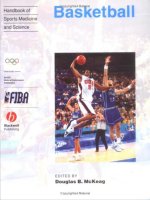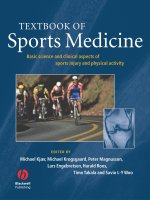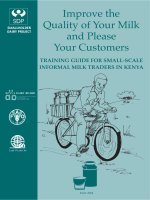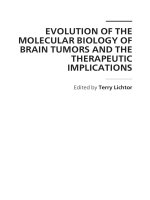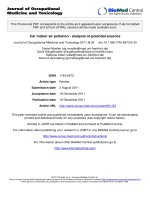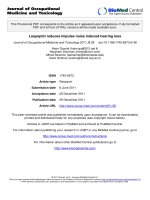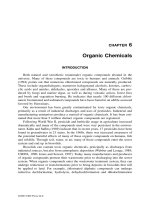Krishen vij textbook of forensic medicine and toxicology 5e elsevier pdf
Bạn đang xem bản rút gọn của tài liệu. Xem và tải ngay bản đầy đủ của tài liệu tại đây (7.53 MB, 612 trang )
Textbook of
Forensic Medicine
and Toxicology
Prelims.indd i
2/9/2011 6:36:39 PM
“This page intentionally left blank"
Textbook of
Forensic Medicine
and Toxicology
Principles and Practice
Fifth Edition
Krishan Vij MD LLB
Head
Department of Forensic Medicine and Toxicology
Adesh Institute of Medical Sciences & Research, Bathinda, Punjab
Former Professor and Head
Department of Forensic Medicine and Toxicology
Government Medical College and Hospital, Chandigarh
Counsellor
Torture Medicine
ELSEVIER
A division of
Reed Elsevier India Private Limited
Prelims.indd iii
2/9/2011 6:36:40 PM
www.cambodiamed.blogspot.com | Best Medical Books | Chy Yong
Textbook of Forensic Medicine and Toxicology, 5/e
Krishan Vij
ELSEVIER
A division of
Reed Elsevier India Private Limited
Mosby, Saunders, Churchill Livingstone, Butterworth-Heinemann and
Hanley & Belfus are the Health Science imprints of Elsevier.
© 2011 Elsevier
First Edition 2001
Second Edition 2002
Third Edition 2005
Fourth Edition 2008
Fifth Edition 2011
All rights are reserved. No part of this publication may be reproduced, stored in a retrieval system, or transmitted
in any form or by any means, electronic, mechanical, photocopying, recording or otherwise, without the
prior permission of the publisher.
ISBN: 978-81-312-2684-1
Medical knowledge is constantly changing. As new information becomes available, changes in treatment, procedures,
equipment and the use of drugs become necessary. The authors, editors, contributors and the publisher have, as far as
it is possible, taken care to ensure that the information given in this text is accurate and up-to-date. However, readers are
strongly advised to confirm that the information, especially with regard to drug dose/usage, complies with current
legislation and standards of practice.
Published by Elsevier, a division of Reed Elsevier India Private Limited.
Registered Office: 622, Indraprakash Building, 21 Barakhamba Road, New Delhi-110 001.
Corporate Office: 14th Floor, Building No. 10B, DLF Cyber City, Phase-II, Gurgaon-122 002, Haryana, India.
Managing Editor (Development): Shabina Nasim
Development Editor: Shravan Kumar
Manager – Publishing Operations: Sunil Kumar
Manager – Production: NC Pant
Typeset by Olympus Infotech Pvt. Ltd., Chennai, India.
Printed and bound at xxx, India.
Prelims.indd iv
2/9/2011 6:36:40 PM
To
the memory of my daughter
Divya Vij
Prelims.indd v
2/9/2011 6:36:40 PM
“This page intentionally left blank"
Foreword
In the present civilised society, every crime ought to be punished and a criminal must be taken to task. Investigators and those who
are engaged in the dispensation of justice require aid of an expert, who, by experience and knowledge, has acquired scientific temperament and skill to unearth the crime. At the same time, with the aid of a forensic expert, an innocent can be saved from the
gallows. Dr. Krishan Vij, in this edition, has put a great effort to notice transformation of medical jurisprudence to clinical forensic medicine. The present edition of Textbook of Forensic Medicine and Toxicology will be of great help not only to the under-graduate
and postgraduate students but to all those who are engaged in investigation of the crime and administration of justice, be it lawyers
or judges, and victims of violence and negligence.
The 5th edition of Textbook of Forensic Medicine and Toxicology by Dr. Vij has summoned the resources of science from all quarters.
Division of contents into segments, viz., (i) Of the Basics, (ii) Of the Dying and the Death, (iii) Of the Injured and the Injuries,
(iv) Clinical Forensic Medicine, (v) Legal and Ethical Aspects of Medical Practice, (vi) Forensic Toxicology, and placement of
illustrations, tables, flowcharts, etc. speak volumes of his experience and expertise spreading over about three decades. Chapters
on brain-stem death vis-à-vis organ donation; sudden and unexpected deaths; custody related torture and/or death; deaths associated with surgery, anaesthesia and blood transfusion; medicolegal examination of the living; complications of trauma (was wounding responsible for death?); medical negligence; informed consent and refusal; and medicolegal aspects of immuno-deficiency
syndrome deserve extreme applause.
Exceptional features of this ensuing edition have been the presentation of cases clinching to the text and updation of information
in every segment. I am sure that the edition would serve as a guiding light for all concerned.
I wish Dr. Vij all success in his endeavour.
Kanwaljit Singh Ahluwalia
Judge
Punjab & Haryana High Court
Prelims.indd vii
2/9/2011 6:36:40 PM
“This page intentionally left blank"
Preface to the 5th Edition
The rapid exhaustion of the last four editions reflects volumes of wide acceptance and popularity of the book, encouraging me to
bring about the 5th edition. The current edition reflects the meticulous work that has been done to revamp its predecessor. Based
on the feedback received from students, teachers, advocates and the judiciary, both Sections of the book (Forensic Medicine and
Forensic Toxicology) have been extensively revised with consequent deletion of outdated information and incorporation of the
new. Extensive placement of photographs, illustrations, tables and flowcharts has made this edition extremely catchy and easy
to grasp. Appearance of enormous references in the flow of the text is the result of extensive study and the period of toil and
turbulence through which I had to creep in. The integral thread of evidence-based description is seen running through the entire
content. Placement of precise information about the relevant legal provisions and forensic aspects of anatomical structures/findings
at appropriate places promote interdisciplinary understanding of issues.
Cases of extreme medicolegal significance, commensurating with the flow of the text, have been introduced to illustrate medicolegal principles and explore solutions to tackle problems usually encountered in day-to-day medicolegal work. And therefore,
the ensuing edition will be of immense help not only to undergraduates and postgraduates (the 'would be' medical practitioners/
experts), but also to wide segments of other professionals engaged in the administration of justice; be it prosecutors, defense
counsels, and of course, the judiciary.
User friendliness of the book is depicted in its lucid style, rational use of various levels of headings, subheadings and boldface
words. Presentation of ‘cases’ is an exceptionally interesting feature of the book helping the user to have an in-depth approach to
the intricacies of medicolegal issues.
Author’s view has always been that the modern time student should not be deprived of the fruits of recent information; therefore,
topics like Sudden and Unexpected Deaths; Deaths due to Asphyxia; Deaths Associated with Surgery, Anaesthesia and Blood
Transfusion; Custody Related Torture and/or Death; Medicolegal Examination of the Living; Injuries by Firearms; Complications
of Trauma: Was Wounding Responsible for Death?; Medical Education via-à-vis Medical Practice; Medical Negligence; Consent
to and Refusal of Treatment, etc., have been thoroughly up-dated with placement of ‘cases’ clinching to the text.
In their effort to add to the learning experience, the publisher, Elsevier, has made use of this book’s companion website
o/Vij/web-home.aspx easy for all students. Now any student can use features like Interactive Assessment,
Downloadable Images and Updates by simply logging in into the Website and creating an ID for self.
In essence, the 5th edition has been nurtured with most recent information, which will serve as an excellent resource for the
undergraduates as well as postgraduate students. Teachers will find it as a guiding light. A wide segment of other professionals
like practitioners (medical as well as legal), investigative agencies, and above all, the judicial officers will also be benefited with
far-reaching content of this edition.
Krishan Vij
Prelims.indd ix
3/1/2011 1:58:28 PM
Acknowledgements
Revision of any book is a gigantic task. The revision of the fourth edition would have not been possible without uninterrupted
encouragement from well-wishers in general and my colleagues in particular. The acutely updated and illustrated fifth edition has
been made possible through rigorous and continued efforts. I am grateful to my friends and colleagues who obliged me through
healthy discussions. While it is not possible to list them all, I record my indebtedness to:
Dr. BBL Aggarwal, Ex-Principal, University College of Medical Sciences and Head of the Department of Forensic Medicine,
New Delhi; for whom my vocabulary fails to locate adequate words of appreciation. An excellent teacher, guide and philosopher,
he has been a source of inspiration and encouragement to me in all walks of my life.
Dr. Gurpreet Inder Singh, Director Principal, AIMS&R, Bathinda (Punjab) and Dean Colleges, Baba Farid University of Health
Sciences, who commands exceptional mention for his constructive and leadership qualities. Hailing from the Army Background,
he has effectively been able to transmit a message of True Army Spirit at the institute as he performs and expects everything in
a scheduled and meticulous manner.
Dr. TD Dogra and Dr. GK Sharma, Head of the Department of Forensic Medicine, All India Institute of Medical Sciences,
and Director Principal, Lady Hardinge Medical College, New Delhi, respectively, distinct and magnanimous personalities in the
field of Forensic Medicine, deserve exclusive appreciation.
Earnest feeling of gratitude are expressed to the authors/writers of various books/journals/articles whose references have
been cited in the text. Dr. JS Dalal, Dr. J Gargi, Dr. RK Gorea, Dr. Dalbir Singh, Dr. AS Thind and Dr. Jagjiv Sharma deserve
thanks for their constructive inputs. Dr. KK Aggarwal, Dr. SS Oberoi, and Dr. DS Bhuller invite appreciation for their interaction.
Dr. Vijay Vij, my brother-in-law, who was instrumental in making me visit various libraries and book centres during my visit to
the United States of America, deserves special appreciation. I was truly amazed by his profound interest in gaining more and more
knowledge and, in fact, I happened to collect rich material from his personal library.
Dr. Parmod Goyal and Dr. Vishal Garg, my colleagues at the Institute, deserve extreme applause for their inputs and
cooperation.
I must confess that I have been highly demanding on quality and accuracy from all staff members of Elsevier, a division of
Reed Elsevier India Pvt. Ltd, sometimes rather impatiently, but all of them have been quite accommodating. In particular, I would
like to pen down my appreciation for Mr. Shravan Kumar, Development Editor, for his pleasant-pitched interaction with an eye
on the market placement.
The users of previous editions are gratefully acknowledged for having brought the textbook at this pedestal. In the past, I have
been benefited from suggestions by colleagues, students, advocates and the judiciary, and I urge them to continue to give their
valuable suggestions.
Before I conclude, I must acknowledge with profound gratitude, the encouragement and inspiration extended to me by wife,
Anu, and my daughter, Divya (during the Herculean exercise of the maiden edition). My wife has been socially bearing the pangs
of loneliness owing to my remaining obsessively occupied. Her contribution, albeit silent, is far-reaching.
Krishan Vij
Prelims.indd x
2/9/2011 6:36:41 PM
Contents
Section 1 Forensic Medicine
PART I
Chapter 1
Of the Basics
Introduction to Forensic Medicine and Indian Legal System
3
Ancient traditional writings describing considerations for regulating human behaviour and providing punishments,
medical ethics, and medical practice for purposes of law | Explanation for the terms forensic, medicine, medical
jurisprudence, legal medicine, forensic pathology, etc. | Police inquest | Magistrate’s inquest | Various Courts in
India | Documentary and oral evidence | Exceptions to oral evidence | Procedure of recording evidence | Dying
declaration and its importance | Kinds of witnesses | Doctor in the witness box
Chapter 2
Medicolegal Autopsy, Exhumation, Obscure Autopsy, Anaphylactic Deaths and Artefacts
17
Clinical and medicolegal autopsy | Precautions for medicolegal autopsy | Objectives of medicolegal autopsy |
Importance of examining clothing | Incisions for the autopsy | Procedure for external and internal examination |
Selection, preservation and dispatch of viscera/specimens | Exhumation | Obscure autopsy | Anaphylactic deaths
| Artefacts
Chapter 3
Identification
35
Complete and incomplete identity | Corpus delicti | Identification in the living | Identification in the dead |
Primary and secondary characteristics | Comparative techniques | Importance of dentition in the medicolegal field
| Age from ‘ossification activity’ of bones | Symphyseal surface in estimating age | Skull sutures in estimating age
| Medicolegal importance of age | Morphological and skeletal changes in determining sex | Intersex states |
Stature from the bones | Medicolegal information from hair, scar, tattoo mark(s), etc. | Skeletal indices for
determining sex and race | Dactylography | Medicolegal information from blood/blood stain | Medicolegal
application of blood groups | Mass disaster | Collection, preservation and dispatch of samples for DNA testing |
OJ Simpson case
PART II
Chapter 4
Of the Dying and the Death
Death and Its Medicolegal Aspects (Forensic Thanatology)
74
Death | Presumption of death and survivorship | Somatic and molecular death | Brain death with its medicolegal
aspects, especially in relation to organ transplantation | Suspended animation | Mode, manner, mechanism and
cause of death | Estimation of ‘time since death’ from the immediate, early and late changes after death, and
factors influencing such changes | Medicolegal aspects of immediate, early and late changes after death |
Differentiation between postmortem staining and bruising, hypostasis and congestion, rigor mortis and cadaveric
spasm, rigor mortis and conditions simulating rigor mortis, etc. | Postmortem damage by predators | Entomology
of the cadaver and postmortem interval
Chapter 5
Sudden and Unexpected Death
100
Concept of ‘sudden’ and ‘unexpected’ death | Morbid anatomy of heart and its blood supply | Types of occlusion
| Sequelae of coronary occlusion | Approaching the cause of death | Postmortem demonstration of myocardial
infarction | Hypertensive heart disease and sudden death | Epilepsy as a cause of unexpected death | Pulmonary
embolism | Vagal inhibition and sudden death | Sudden death in infancy
Prelims.indd xi
2/9/2011 6:36:41 PM
xii Contents
Chapter 6
Asphyxial Deaths
110
Asphyxia and its types | Asphyxial stigmata | Suffocation and its types | Medicolegal aspects of carbon monoxide
and carbon dioxide | Medicolegal aspects of smothering, gagging, choking, traumatic asphyxia, burking, etc. |
Mechanism of death by compression of the neck | Types, cause of death, autopsy findings and the circumstances
of hanging | Types, cause of death, autopsy findings and circumstances of strangulation | Mugging, garroting,
bansdola, palmar strangulation, etc. | Types, mechanism of death, cause of death, pathophysiology, and diagnosis of
death in drowning | Floatation of body in water | Circumstances of drowning
Chapter 7
Infanticide and Foeticide
146
Infanticide and the related law | Primary and secondary issues to be resolved in relation to infanticide | Age of
viability and its medicolegal significance | Concept of live birth and separate existence | Proof of live birth |
Hydrostatic test and its importance | Other tests for separate existence | Probable duration of life of the child |
Autopsy | Cause of death, i.e. acts of commission and acts of omission | Foeticide | Abandoning of children and
concealment of birth | Development of foetus
Chapter 8
Thermal Deaths
159
Heat regulation, systemic hyperthermia (heat cramps, heat exhaustion and heat stroke) | Character of burns produced
by various agents | Different classification of burns | Rule of nine | Causes of death in burn | Nature of burn
injury in the absence of death | Age of burn injury | Autopsy findings | Medicolegal aspects of death due to burns
| Antemortem and postmortem differentiation of burns | Some legal provisions in relation to dowry death |
Scalds and their medicolegal aspects | Differentiation of injuries due to dry heat, moist heat and chemicals |
Pathophysiology of hypothermia | Circumstances of injury due to cold | Autopsy findings in death due to cold
Chapter 9
Starvation and Neglect
173
Starvation and its types | Autopsy findings | Circumstances of death | Malnutrition
Chapter 10
Death by Electrocution
175
Types of fatal electrocution | Factors influencing effects of electricity | Mechanism of death | Autopsy findings
in ‘medium-tension’ and ‘high-tension’ currents | Joule burn (endogenous burn) | Circumstances of electrocution
| Iatrogenic electrocution | Judicial electrocution | Lightning and mechanism of injury by it | Circumstances of
lightning
Chapter 11
Deaths Associated with Surgery, Anaesthesia and Blood Transfusion
183
Surgical intervention | Respiratory embarrassment | Cardiac embarrassment | Regional and spinal anaesthesia |
Instruments and instrumentation | Unforeseeable problems | Precautions for autopsy | The autopsy | Medicolegal
considerations | Blood transfusion—hazards and risks | Periprocedural complications, etc.
Chapter 12
Custody Related Torture and/or Death
191
Meaning of custody and torture | Methods of torture | Circumstances of death | Related cases | Role of autopsy
surgeon | Incisions at autopsy
PART III
Chapter 13
Of the Injured and the Injuries
Injuries: Medicolegal Considerations and Types
197
Wound, trauma, injury, etc. | Mechanism of production of mechanical injuries | Differentiation between
antemortem and postmortem wounds | Wound healing | Important Sections of IPC relating to offences against
the human body | Simple, grievous and dangerous injuries | Classification of injuries
Prelims.indd xii
2/9/2011 6:36:41 PM
Contents xiii
Chapter 14
Injuries by Blunt Force
213
Forensic aspects of the anatomy of skin | Abrasion and its types | Patterned abrasions | Fate of an abrasion |
Differentiation between antemortem and postmortem abrasions | Medicolegal aspects of abrasions | Bruise
(contusion) and factors influencing its production | Migratory/ectopic bruising | Fate of a bruise | Patterned
bruising | Differentiation between antemortem and postmortem bruising | Medicolegal aspects of bruising |
Lacerations and its types | Incise-looking wounds | Features of lacerations | Differentiation between antemortem
and postmortem lacerations | Medicolegal aspects of laceration
Chapter 15
Injuries by Sharp Force
225
Incision/cut/slash, etc. | Features of incised wounds | Bevelled cuts | Hesitation cuts | Chopping wounds |
Types and features of stab wounds | Factors influencing size, shape and configuration of stab wounds | Injuries
by blunt penetrating/dull instruments | Wounds by glass | Pointers towards suicide/accident/homicide
Chapter 16
Injuries by Firearms
234
Types of firearms | Types of ammunition | Parts of cartridge and their functions | Mechanism of bullet wound
production | Characters of wounds produced by rifled and smoothbore firearms | Exit wounds by rifled and
smoothbore weapons | Direction of fire | Unusual circumstances in firearm injuries | Various tests for firearm
residues | Autopsy in firearm fatalities | Suicide, accident or homicide
Chapter 17
Injuries by Explosives
266
Mechanism of production of injuries by bomb blast | Autopsy in explosion fatalities | Medicolegal considerations
in explosion injuries
Chapter 18
Regional Injuries
270
Injuries of the scalp including forensic aspects of anatomy of the scalp | Fractures of the skull including forensic
aspects of anatomy of the skull | Mechanism of production of skull fractures | Meningeal haemorrhages with
their medicolegal aspects | Mechanism of production of cerebral injuries | Medicolegal aspects of coup and
contrecoup injuries | Concussion | Head injuries in boxers | Spinal injuries with their medicolegal aspects | Facial,
cervical, thoracic and abdominal trauma
Chapter 19
Transportation Injuries
296
Mechanism of vehicular injury | Pattern of injuries to the driver, front-seat occupants and rear-seat occupants of
a motor car | Pattern of injuries to the pedestrians, motor cyclists and pedal cyclists, etc. | Aircraft accidents,
railway accidents and vehicular conflagration | Medicolegal aspects of transportation injuries
PART IV
Chapter 20
Clinical Forensic Medicine
Medicolegal Examination of the Living
304
Clinical forensic medicine | Medicolegal examination of the victim of assault and extending opinion | Classification of
sexual offences | Meaning and scope of the offence of ‘rape’ with particular emphasis on implications of consent/
nonconsent | Medicolegal examination of the victim and of the alleged accused of rape and extending opinion in either
case | Medicolegal examination in ‘unnatural sexual offences’ and extending opinion | Medicolegal aspects of ‘semen’
| Acid phosphatase test and its medicolegal importance | Medicolegal importance of pregnancy | Presumptive,
probable and positive signs of pregnancy | Differential diagnosis of pregnancy | Surrogate motherhood | Child abuse
Chapter 21
Complications of Trauma: Was Wounding Responsible for Death?
335
Immediate causes of death—primary or neurogenic shock; injury to vital organ(s); haemorrhage; air embolism |
Delayed causes of death—secondary shock; wound infection; pulmonary thromboembolism; fat and bone marrow
Prelims.indd xiii
2/9/2011 6:36:41 PM
xiv Contents
embolism; crush syndrome; exacerbation of pre-existing disease | Trauma and operation/anaesthesia | Weapon
and its implications
PART V
Legal and Ethical Aspects of Medical Practice
Chapter 22
Medical Education vis-à-vis Medical Practice
346
Ethics and moral in relation to medical practice | Various ‘codes’ of medical ethics | Constitution and powers of
the Indian Medical Council | Constitution and powers of the State Medical Council | Code of ethics by Medical
Council of India | Duties of doctors towards patients and towards each other | Duties of doctors towards the state
| Professional secrecy and privileged communication | Professional misconduct/infamous conduct/malpractice |
Difference between unethical conduct and misconduct | Red Cross emblem policy
Chapter 23
Medical Negligence
361
Negligence and its various components | Medical negligence—differentiation from negligence in other fields |
Mistaken diagnosis/errors of clinical judgement whether amount to negligence | Defensive medicine | Proof of
negligence with particular emphasis on the doctrine of ‘res ipsa loquitur’ | Contributory negligence | Vicarious
liability | Medical product liability | Criminalisation of negligence | Failure to take X-ray—whether amounts to
negligence | Consumer Protection Act and medical negligence
Chapter 24
Consent to and Refusal of Treatment
370
Types of consent | Scope of consent | Doctrine of informed consent and its components | Hospital’s role | Ability
to consent | Exceptions to material disclosure | Evidentiary proof of adequate disclosure | Decision-making for
the patient without capacity | Sections 53, 53A and 164A CrPC in relation to consent | Doctor-assisted suicide and
euthanasia
Chapter 25
Acquired Immunodeficiency Syndrome: Medical, Social, Ethical and Legal Implications
376
Healthcare worker(s) with HIV infection | Criminalisation of HIV transmission | AIDS and autopsies | Universal
blood and body fluid precautions
Chapter 26
Abortion and Delivery
380
Abortion and its classification | Grounds for justifiable abortion | Rules of the MTP Act | Methods of inducing
abortion under the MTP Act | Methods used in criminal abortion | Unskilled, semi-skilled and skilled interference
for inducing abortion | Abortion stick and its hazards | Enema syringe and its hazards | Complications of criminal
abortion | Examination of a woman who has allegedly aborted | Differentiation between nulliparous and parous
uterus | Penal provisions relating to criminal abortion
Chapter 27
Impotence, Sterility, Sterilisation and Artificial Insemination
393
Impotence and sterility | Examination of a case of impotency and sterility and expressing opinion | Causes of
impotence and sterility in the male and female | Medicolegal aspects of sterilisation | Types, procedures, guiding
principles and legal status of artificial insemination | Test tube baby | Concept of ‘wrongful pregnancy’, ‘wrongful
birth’ and ‘wrongful life’ cases
Chapter 28
Nullity of Marriage, Divorce and Legitimacy
400
Circumstances for void and voidable marriage | Legitimacy of children of void and voidable marriages | Grounds
for divorce | Alternate relief in divorce proceedings | Medicolegal issues relating to legitimacy | Some important
considerations
Chapter 29
Forensic Psychiatry
405
Forensic psychiatry | Various ‘terms’ in the Mental Health Act | Signs/symptoms of mental disturbance with their
medicolegal importance | Mental retardation | Psychosis and neurosis | Association of cerebral tumours,
pregnancy and epilepsy with psychosis | Personality disorders | Diagnosis of mental illness | True and feigned
Prelims.indd xiv
2/9/2011 6:36:42 PM
Contents xv
mental illness | Restraint of the mentally ill | Civil and criminal responsibility of the mentally ill | Criminal
responsibility for offence committed during intoxication | Sexual perversions/deviations (paraphilias)
Section 2 Forensic Toxicology
Chapter 30
Basic Considerations in Drugs/Chemicals
429
Meaning of the terms pharmacology, drug, dose, therapeutic dose, effective dose, lethal dose, etc. | Routes of
administration | Pharmacokinetics of drugs/chemicals | Pharmacodynamics of drugs/chemicals | Mechanism of
action of drugs/chemicals | Analytical methods in toxicology | Classification of poisons
Chapter 31
Intricacies of Forensic Toxicology
438
Historical background of forensic toxicology | Concept and scope of toxicology | Definition of ‘poison’ and its
implications | Statutes on drugs/poisons in India | Sections of IPC concerned with poisons and poisoning |
Factors modifying action of drugs/chemicals | Concept of fatal dose | Evidence of poisoning in the living and
the dead | Techniques of obtaining samples and interpretation of results | Relative toxicity of drugs/chemical
Chapter 32
Duties of a Doctor in Cases of Suspected Poisoning
448
Circumstances needing reporting to the police | Steps involving management of poisoning | Various types of
antidotes | Principles of chelation therapy and various chelating agents
Chapter 33
Corrosive Poisons
454
Classification of corrosives and mechanism of action | Vitriolage and its medicolegal importance | Comparison
of features of mineral acids | Medicolegal aspects of mineral acid poisoning | Source, clinical findings, diagnosis,
management and medicolegal aspects of carbolic acid, oxalic acid and salicylic acid poisoning
Chapter 34
Nonmetallic and Metallic Irritants
463
Features, diagnosis and management of poisoning by nonmetallic irritants like phosphorus and its medicolegal
aspects | Features, mechanism of action, diagnosis and management of poisoning by metallic irritants like arsenic,
lead, mercury, etc., and their medicolegal aspects | Features, mechanism of action, diagnosis and management of
thallium poisoning
Chapter 35
Irritants of Plant Origin
476
Features, mechanism of action, fatal dose, fatal period and medicolegal aspects of important plant irritants
Chapter 36
Irritants of Animal Origin
481
Epidemiology and identification of snakes | Composition pharmacology and pathophysiology of snake venom |
Toxicity resulting from bites of different types of snakes | Management of snake bite | Medicolegal aspects of
snake bite | Features of irritant arthropods and attributes of their venom with medicolegal aspects
Chapter 37
Somniferous Group
489
Source, extraction and characteristics of opium | Alkaloids of opium | Mechanism of action and metabolism |
Acute and chronic morphine poisoning | Features of ‘heroin’ poisoning with medicolegal aspects | Medicolegal
aspects of ‘pethidine’ and ‘methadone’ poisoning
Chapter 38
Alcohol and Alcoholism
495
Source and consideration in various preparations | Consumption, absorption and elimination of alcohol with
medicolegal aspects | Stages of alcohol intoxication with fatal dose and fatal period | Alcohol withdrawal syndrome |
Drunkenness and its medicolegal aspects | Death in acute alcoholic poisoning | Collection and preservation of blood
and urine samples | Alcoholism and drug dependency | Medicolegal examination in a case of alcohol intoxication
Prelims.indd xv
2/9/2011 6:36:42 PM
xvi Contents
Chapter 39
Non-narcotic Drug Abuse
506
Methods and hazards of non-narcotic drug abuse | Toxicology and medicolegal aspects of barbiturates,
amphetamines, tricyclic antidepressants, benzodiazepines, hallucinogens, cocaine and Cannabis, etc. | Drug abuse
in sports
Chapter 40
Deliriant Poisons
518
Features of poisoning by dhatura and its alkaloids | Medicolegal aspects of dhatura poisoning
Chapter 41
Spinal Poisons
521
Source, mechanism of action and features of strychnine poisoning with medicolegal aspects | Important poisons
affecting peripheral nerves
Chapter 42
Cardiac Poisons
525
Source, characters, mechanism of action, metabolism, features and management of nicotine poisoning | Nicotine
replacement therapies | Medicolegal aspects of nicotine poisoning | Source, characters, mechanism of action and
features of aconite and oleander poisoning
Chapter 43
Agro-Chemical Poisoning
531
Classification and toxicity of various pesticides | Toxicology, management and medicolegal aspects of
organophosphates, carbamates, organochlorine group of compounds | Toxicology of herbicides like paraquat,
diquat, and rodenticides etc.
Chapter 44
Fumigants
541
Toxicology, diagnosis and management of aluminium phosphide poisoning | Medicolegal aspects of aluminium
phosphide poisoning
Chapter 45
Asphyxiants
546
Harmful action of hydrocyanic acid and its salts | Diagnosis and management of hydrocyanic acid poisoning with
medicolegal aspects | Major air pollutants, their sources and harmful effects
Chapter 46
Poisoning in Conflict: Chemical and Biological Warfare Agents
552
Chemicals used in warfare | Toxicology of compounds causing pulmonary oedema and other complications |
Biological agents used in warfare
Chapter 47
Hydrocarbons—Petroleum Distillates
558
Toxicity of hydrocarbons with medicolegal aspects | Abuse of volatile substances with medicolegal aspects
Chapter 48
Food Poisoning and Essential Metals’ Toxicity
562
Types of bacterial food poisoning | Toxicity of some harmful bacteria | Foods acting as poisonous materials |
Food allergy | Essential metals’ toxicity
Annexures
Annexure 1
Scientific Aids to Investigative Techniques
571
Annexure 2
Proforma for Age Certification
573
Annexure 3
Proforma for Medicolegal Examination of Injuries
575
Prelims.indd xvi
2/9/2011 6:36:42 PM
Contents xvii
Annexure 4
Proforma for Examination of a Victim of Sexual Assault
577
Annexure 5
Proforma for Examination of an Accused of Sexual Offence
579
Annexure 6
Issuing/Supplying Copies of Injury and/or Postmortem Reports (MLR and/or PMR)
581
Annexure 7a Penal Provisions Applicable to Medical Persons
582
Annexure 7b Penal Provisions Affording Protection to Medical Persons
583
Annexure 8
Index
Prelims.indd xvii
Standard Weights/Measures/Dimensions of Organs/Tissues
584
585
2/9/2011 6:36:42 PM
“This page intentionally left blank"
A medicolegist must avoid
talking too much,
talking too soon and
talking to the wrong persons.
Section 1
”
Forensic Medicine
PART I Of the Basics
Chapter 1 Introduction to Forensic Medicine and Indian Legal System
Chapter 2 Medicolegal Autopsy, Exhumation, Obscure Autopsy, Anaphylactic Deaths and Artefacts
Chapter 3 Identification
PART II
Chapter 4
Chapter 5
Chapter 6
Chapter 7
Chapter 8
Chapter 9
Chapter 10
Chapter 11
Chapter 12
Death and Its Medicolegal Aspects (Forensic Thanatology)
Sudden and Unexpected Death
Asphyxial Deaths
Infanticide and Foeticide
Thermal Deaths
Starvation and Neglect
Death by Electrocution
Deaths Associated with Surgery, Anaesthesia and Blood Transfusion
Custody Related Torture and/or Death
PART III
Chapter 13
Chapter 14
Chapter 15
Chapter 16
Chapter 17
Chapter 18
Chapter 19
Of the Dying and the Death
Of the Injured and the Injuries
Injuries: Medicolegal Considerations and Types
Injuries by Blunt Force
Injuries by Sharp Force
Injuries by Firearms
Injuries by Explosives
Regional Injuries
Transportation Injuries
PART IV
Clinical Forensic Medicine
Chapter 20 Medicolegal Examination of the Living
Chapter 21 Complications of Trauma: Was Wounding Responsible for Death?
PART V
Chapter 22
Chapter 23
Chapter 24
Chapter 25
Chapter 26
Chapter 27
Chapter 28
Chapter 29
Chap-01.indd 1
Legal and Ethical Aspects of Medical Practice
Medical Education vis-à-vis Medical Practice
Medical Negligence
Consent to and Refusal of Treatment
Acquired Immunodeficiency Syndrome: Medical, Social, Ethical and Legal Implications
Abortion and Delivery
Impotence, Sterility, Sterilisation and Artificial Insemination
Nullity of Marriage, Divorce and Legitimacy
Forensic Psychiatry
2/9/2011 2:51:22 PM
“This page intentionally left blank"
1
CHAPTER
Introduction to Forensic Medicine and
Indian Legal System
After going through this chapter, the reader will be able to describe: Ancient traditional writings
describing considerations for regulating human behaviour and providing punishments, medical
ethics, and medical practice for purposes of law | Explanation for the terms forensic, medicine,
medical jurisprudence, legal medicine, forensic pathology, etc. | Police inquest | Magistrate’s
inquest | Various Courts in India | Documentary and oral evidence | Exceptions to oral
evidence | Procedure of recording evidence | Dying declaration and its importance | Kinds of
witnesses | Doctor in the witness box
Development of medicine can be considered as old as
mankind. To the earliest man, medicine was known in the form
of magic, witchcraft and worship of various objects of nature.
To protect themselves from their charlatan effect, the ancient
men framed a set of regulations, which was the origin of medical jurisprudence. Manu (3102 BC) was the first traditional
king and lawgiver in India. His famous treatise, Manusmriti, laid
down the various laws prevailing in those days. It prescribed
specific rules for marriages. Punishment for various offences
was mentioned in it, viz., for adultery, seduction and carnal
knowledge with force, incest, unnatural sexual offences, etc.
Mental incapacity due to intoxication, illness and age were also
recognised.
The first treatise on Indian Medicine was the Agnivesa
Charaka Samhita, supposed to have been composed about the
seventh century BC. It lays down an elaborate code regarding
the training, duties, privileges and social status of physicians. It
can be considered as the origin of medical ethics. It also gives
a detailed description of various poisons, symptoms, signs and
treatments of poisoning.
A significant development occurred between the fourth and
third century BC. The Arthashastra of Kautilya was the law
code of this period. Penal laws were well-defined, medical
practice was regulated and medical knowledge utilised for the
purposes of law. Sushruta, the father of Indian Surgery, was
another famous authority in the Indian system of medicine.
Sushruta Samhita was composed between 200 and 300 AD. The
chapters concerning forensic medicine were so carefully written that they are in no way inferior to modern knowledge on
the subject.
During the medieval period, India was invaded by foreign
powers like Turks, Mongols and Mohammedans. Civilisation and
culture of India suffered a serious setback in all respects. The
Portuguese, the Dutch, the French and the British also invaded
the country and ultimately, the British ruled over the country
from the middle of the eighteenth century to the middle of the
twentieth century. In 1822, the first medical school was established in Kolkata and converted into Medical College in 1835.
The first chair in Medical Jurisprudence was instituted in
Calcutta Medical College in 1845, and Dr. CTO Woodford was
the first Professor of Medical Jurisprudence in the country. It
is obvious that the subject was born as a concrete separate
branch of medical discipline by dint of its own merit, until it
reached its present status. The history of the subject is the ‘key
to the past, explanation of the present and/or signpost for the
future.’
While introducing the subject of Forensic Medicine, the
natural and obvious query that appears in one’s mind is about
the meaning and scope of the words ‘forensic’ and ‘medicine’.
The word ‘forensic’ has been derived from the Latin word
‘forensis’, which implies something pertaining to ‘forum’. In
Rome, ‘forum’ was the meeting place where civic and legal matters used to be discussed by those with public responsibility.
Thus, the word ‘forensic’ essentially conveys any issue related to
the debate in the courts of law. The word ‘medicine’ carries
wide import. Broadly, it may be considered as a science for preserving health and effecting cure. From the interaction of these
two professions, medicine and law, has emerged the discipline/
subject of Forensic Medicine, i.e. application of medical and
allied knowledge and expertise towards the administration of
4 Textbook of Forensic Medicine and Toxicology
justice. Forensic Medicine was earlier known as ‘Medical
Jurisprudence’. It was also termed as ‘State Medicine’; this
term was recommended by Dr. Stanford Emersion Chaille
(1949) and was developed to regulate the code of conduct for
registered medical practitioners, to guide and regulate the professional activities of the doctors and to standardise and
supervise the medical practice in the country. In Europe and
United States, the term ‘Legal Medicine’ (application of
medical knowledge for solution of legal problems) is often
preferred. However, in most parts of the world, the description
‘Forensic Medicine’ is widely accepted. In short, it denotes
‘medical aspects of law’, whereas the term ‘Medical
Jurisprudence’ (Juris = law, and Prudentia = knowledge) denotes
application of knowledge of law in relation to practice of
medicine.
Whatever may be the name, the subject spreads into almost
every branch of medicine and is certainly not confined to
criminal matters. It covers responsibilities of doctors towards
the State, patients and towards each other. With the enormous
advances in knowledge and technology during the past decades,
the fields like Forensic Odontology, Forensic Osteology,
Forensic Biology, Forensic Ballistics, Forensic Psychiatry and
Forensic Serology, etc. have come to be recognised as specialisations in themselves. Forensic Pathology essentially deals
with interpretation of autopsy findings in a medicolegal investigation of death. It still rests largely on the principles of
morbid anatomy.
Forensic medicine plays a remarkable role in guarding safety
of each individual and also in ensuring that any accused is not
unjustly condemned. Instances may be legion, but a single
illustration would be sufficient at this juncture: a man may
die of coronary thrombosis while walking on a road and subsequently be run over by a vehicle and the driver charged with
‘culpable homicide not amounting to murder’. Histochemical
and biochemical studies of the injured tissue would establish
the postmortem origin of the injuries and the examination of
the coronary vasculature will reveal the presence of disease;
thereby clearing the issues and helping in the disbursement of
justice when the concerned doctor is called upon to depose in
a court of law. It is obvious that if the medical aspects of such
cases are not interpreted in a proper forensic perspective, pans
of justice may remain ill-balanced.
Indian Legal System
Although the terms ‘Medical Jurisprudence’, ‘Legal Medicine’
and ‘Forensic Medicine’ are commonly used to denote the
branch of medicine that deals with the application of knowledge of medicine for the purpose of law, yet they bear different
implications. Medical Jurisprudence embraces all medical
issues affecting social rights/obligations of the individual
as well as the doctors and brings the medical practitioner in
contact with the law. Thus, medical jurisprudence deals with the
legal aspect of medical practice, whereas Forensic Medicine
deals with the application of medical knowledge towards
administration of justice. It is, therefore, essential for a medicolegal expert to have a fair knowledge of all the branches of
medical and ancillary sciences. It is often required to invoke the
aid of these subjects in the elucidation of various problems of
medicolegal interest. Forensic Medicine is a practical subject.
Class lectures should, therefore, be illustrated with practical
examples and students should get ample opportunities to
observe and discuss cases of varied magnitude. They should be
carried to the courts to observe lively debate of the opposing
counsels.
Following is the further discussion of the various important
components of Indian legal system. Table 1.1 describes the
categories of courts and their respective powers.
Legal Procedure at an Inquest
Inquest (in = in; quasitus = to seek) means legal or judicial
inquiry to ascertain a matter of fact. In forensic work, an
inquest implies an inquiry into the cause of death that is apparently not due to natural causes. Such an inquiry/investigation
into sudden/suspicious/unnatural death is obviously necessary to apprehend and punish the offender. For various indications of inquest see Fig. 1.1 and Flowchart 1.1.
POLICE INQUEST
The inquest is held by a police officer (called Investigating
Officer) not below the rank of Senior Head Constable.
Procedure
Police officer, on receipt of information of death, proceeds
to the place of occurrence and holds an inquiry into the
matter in the presence of men of the locality.
He takes all reasonable steps to investigate the case and
writes a report describing the appearance of the body,
wounds (how were they caused and by what weapon).
The witnesses are called panchas (Panch witnesses or
Panchayatdars). He obtains the signatures of the witnesses
there and then. (Witnesses should preferably be some
respectable persons of the locality/area.) The inquest
report so prepared is known as panchnama.
If no foul play is suspected, the dead body is released to the
relatives of the deceased for disposal.
In every case where death appears to have been due to suicidal, homicidal, accidental or suspicious causes, or where it
appears to the officer conducting the investigation (whether
under Section 157 or 174 CrPC) expedient to do so, the body
is to be sent for the postmortem examination to the nearest
medical officer of the government hospital/dispensary
Chapter 1
Introduction to Forensic Medicine
5
and Indian Legal System
Table 1.1 Categories of Courts in India
Supreme Court: Highest judicial tribunal of India, situated in
New Delhi
Can pass any sentence. Usually considers appeals from lower
courts. It can sustain or alter the punishment approved or
awarded by the High Court
High Court: Highest judicial tribunal of the State, usually situated
in the capital of the State
Can pass any sentence. Usually exercises appellate jurisdiction.
Confirmation of death sentence passed by the Sessions Court
Sessions Court (Sessions Judge): Highest judicial tribunal of
the District, usually situated at the district headquarters
Can pass any sentence. However, death sentence has to be
confirmed by the High Court
Additional Sessions Judge: High Court may appoint
Additional Session Judges to exercise jurisdiction in a Court
of Session
Same as Sessions Court
Assistant Session Judge: High Court may also appoint Assistant
Session Judges depending upon the demands. Such court may
be situated at district headquarters or any other place considered
suitable
Can pass any sentence except death sentence, life
imprisonment or imprisonment exceeding 10 years
Chief Judicial Magistrate/Chief Metropolitan Magistrate:
In every district, High Court shall appoint a Judicial Magistrate
of first class having sufficient experience to be the Chief Judicial
Magistrate (in the Metropolitan area, it is called as Chief
Metropolitan Magistrate)
Can pass any sentence except a sentence of death or of
imprisonment for life or of imprisonment exceeding 7 years.
Fine without limit. However, Section 63 IPC lays down that
where no sum is expressed to which the fine may extend, the
amount of fine to which the offender is liable is unlimited, but
shall not be excessive; that is to say that the amount of fine
imposed should be within the means of the accused to pay
though he must be made to feel the pinch of it. Imprisonment
in default of fine should also be long enough to induce the
accused to pay the fine rather than suffer the imprisonment
Judicial Magistrate (First Class)/Metropolitan Magistrate
Can pass sentence of imprisonment for a term not exceeding
3 years or of fine not exceeding | 10,000, or both
Judicial Magistrate (Second Class)
(In every district, as many courts of Judicial Magistrates of first
class and of the second class may be established as the state
government may, after consultation with the High Court, specify
by notification)
Can pass sentence of imprisonment for a term not exceeding
1 year or of fine not exceeding | 5000, or both
Special Judicial Magistrates: Government may, after
consultation with the High Court, establish one or more special
Courts of Judicial Magistrate of first class or the second class
to try any particular case or particular class of cases. Such
magistrates may be appointed for any term, not exceeding
1 year at a time
High Court may empower such Special Judicial Magistrates to
exercise the powers of a Metropolitan Magistrate in relation to
any metropolitan area outside its local jurisdiction
or some private institution having been authorised for
conducting medicolegal postmortems. The doctor, after
conducting the postmortem, should handover the postmortem report and the dead body to the police there and
then.
Chapter 25 of Punjab Police Rules, Volume III, deals with
the investigation by the police. Rule 25.31 is concerned
with the inquest, and Rule 25.35 deals with the ‘Inquest
Report’. The investigating officer has to draw up the
report in Forms 25.35 (1) A, B or C in accordance with the
manner in which the deceased person appears to have died,
viz.: Form A—death due to natural causes; Form B—death
by violence and Form C—death by poisoning. The report
is signed by the police officer conducting the investigation
and by so many of the persons assisting in the investigation.
Such report must contain documents like (i ) plan of the
scene of death, (ii ) inventory of clothing, (iii ) list of articles
on and with the body and (iv) list of articles sent for medical/
chemical examination, etc. [It has been stressed by the Apex
Court that the officer holding the inquest on a dead body
should hold the inquest on the spot—KP Rao vs. Public
Prosecutor, 1975, SCC (CV) 678].
PART I Of the Basics
Powers
Section 1
Court
6 Textbook of Forensic Medicine and Toxicology
Sudden death
Industrial diseases
Death in
custody
Drugs and/or
poisons
Abortions
Suicide
Homicide
INQUEST
Industrial
accidents
Allegations of
negligence
Domestic
accidents
Operational death
Infant deaths
Road accidents
Fig. 1.1 Diagrammatic illustration showing indications for inquest.
Police Inquest
(Section 174 CrPC)
To be conducted by
Officer In Charge of a
police station or some
other police officer
empowered by the
Govt.
• Suicide
• Homicide
• Killing by any animal
or machinery or
accident, etc.
• Death under circumstances raising a
reasonable suspicion
that some other
person has committed an offence
• Death of a woman
within 7 years of her
marriage and any
relative of the woman
has made a request
in this behalf
Magistrate’s Inquest (Section 176 CrPC)
To be conducted by District Magistrate/Sub-divisional Magistrate/Executive Magistrate/Judicial Magistrate
• Suicide by a woman
within 7 years of her
marriage
AND
• Death of a woman
within 7 years of her
marriage in the circumstances raising a
reasonable suspicion
that some other
person has committed
an offence in relation
to such woman.
(Inquest in these two
circumstances shall be
held by the magistrate)
• In any case mentioned
under the police inquest
but excluding two circumstances as narrated,
magistrate may hold an
inquiry into the cause of
death either instead of, or
in addition to, the investigation held by the police
(a) When any person
dies or disappears,
or
(b) Rape is alleged
to have been
committed on any
woman; while
such person or
woman is in the
custody of police
or in any other
custody. (The
inquiry shall be
held by the judicial
magistrate or the
metropolitan
magistrate in
addition to the
inquiry or investigation held by
the police)
Flowchart 1.1 Circumstances necessitating police or the magisterial inquest/inquiry.
Wherever it is considered
expedient to make an
examination of the dead
body of any person who
has been already interred,
the magistrate may cause
the body to be disinterred
and examined to discover
the cause of death

